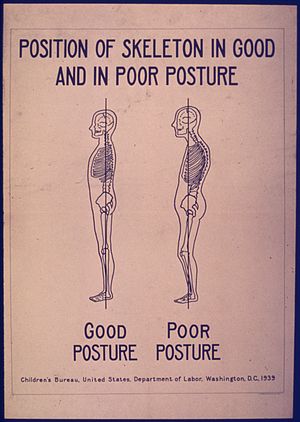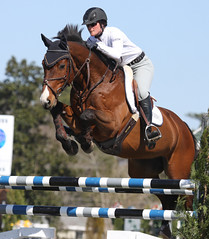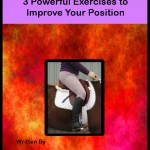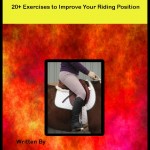Sitting Straight, Improve Your Equitation by Sitting in the Saddle Correctly
Do you have that nagging feeling you are sitting incorrectly? It may be uneven stirrups, horse won’t bendor even sore back or hip. Take a look and find out if you are sitting squarely in the saddle.
Are You Straight?
Let me tell you right now I am not kinesiologist or muscle specialist. I just notice the way your horse goes in the ring. If you are not straight, how do we expect our horses to travel straight, change leads and bend?
Be Aware Of Your Posture

Being aware of your posture is the first step. While sitting in your horse take a few moments to really feel how you are sitting in the saddle. Minute changes can have a beneficial effect on your position and on your horse.
Sit on your saddle and do a positional check. Starting from the ground up:
- heels- relaxed and down. Is one heel lower or more relaxed than the other. Do you feel the weight in one heel more than the other?
- Ankles – Are they both flexed and ready to absorb? Some people who have had an injury to an ankle find there injured ankle, less supple.
- Knees – Look closely at where your knees are, or better yet, ask a knowledgeable friend to look at your knees. Often right handed people are naturally stronger on their right side. Sometimes this reveals itself as a tighter left knee or a knee which is jammed into the knee roll.
- Hip – Feel how your hips are in the saddle. Right handed people are often stronger through their whole right hand side and therefore their right hip and leg often pulls them over to the right hand side of the saddle.
- Spine and back – Feel how your spine is straight up through the middle. Having a supple and relaxed back is important to feel your horse and to receive the movement and messages from the horse. Your spine should never be hollowed and as ‘The Ethics and Passions of Dressage’, by Charles DeKnuffy Says in his book, “do not ever arch or hollow the lower back and thereby stiffen it. That horrible position nulliies the functions of the lower back, which in my opinion is where riding is!”
- Head – Always up and looking forward.
Some Exercises to Help Strengthen Your Riding Position
For more riding exercises purchase my ebook 20+ Exercises to Improve Your Position. Here are a sample of some of the powerful exercises used to strengthen your riding position.
Arm Raises

Center yourself as if you were sitting on a horse. Close your eyes and slowly reach your right hand above your head. Now notice what happens to your body. Do your shoulders stay square? Or does your left shoulder ‘dip down’ as your reach up? Does your body stay still and square or do you collapse through your left rib cage?
Repeat this exercise while maintaining level shoulders. Keep the distance from the bottom of your left rib cage to the top of your left hip, the same as the bottom of your right rib cage to the top of your right hip. This prevents you from slouching through the left hand side of your body.
Please note this exercise is meant to show riders how to isolate and have independent arms and body torso. By raising your arm directly above your head and keeping your shoulders and torso level you can teach yourself to control your muscles and signal your horse more accurately.
This is different than wanting to stretch through your side, in which case you will want to fell a stretch through your side and shift your weight allowing the stretch to happen.
Things to remember
How far you can reach without shifting your weight or dropping your shoulder?
Jockey Stirrups
This is a fun and simple exercise that will help develop a secure, independent seat. While mounted, take your feet out of the stirrups and roll the stirrup leathers about four times and then buckle it back up into the normal hole your ride in. The stirrups should be adjusted so they reach about mid shin and your knees are above the saddle knee rolls, or shorter (when I did this, we used to have to have our knees above the horse’s withers!).
To begin, walk with your feet in the stirrups and your seat in the saddle. Having your stirrups this short is a killer and you will feel it in your thighs and calves. While walking notice how you can feel your seat bones in the saddle. By riding with your stirrups so short you are forced to keep your seat bones deep in the saddle.
This exercise helps develop an independent seat and leg. With your knees above the knee rolls of the saddle and only your seat in the saddle, you will be required to balance in the saddle with your seat bones. You will not be able to grip with your knees to keep your seat secure.
Extra short stirrups will also develop a stretch through your calves and help keep your heels deep and secure.
After getting comfortable at the walk, stand up in your stirrups for a few strides and feel how your calves and heels are very secure with the weight of your body. With your right hand reach forward and grab a handful of mane half way up the horse’s neck and pull yourself off your seat bones so you are balanced over your stirrups with your seat off of the saddle.
Standing in the stirrups will help promote the balance required and encourage the correct use of your legs. While standing in your stirrups, you will be required to balance without falling on your seat back into the saddle. This will develop your understanding of your center of gravity and how to keep your weight centered over your leg.
It will also help develop the muscle strength required for riding. Balanced over your leg, you should feel your heel drop down and the weight come into your stirrup and lower leg. Keep hold of the mane and slowly lower your body back down. Repeat this five times to help strengthen your leg and improve your balance. It is important to control how you lower your seat back into the saddle.
How many steps can you stand up in your stirrups? The better balanced you are the more steps you can manage.
Now perform this exercise at the trot. It can be done at the sitting trot, rising trot and two-point trot. While sitting the trot you will notice that your seat bones will remain in the saddle.
Things to Remember
Start out by performing with your stirrups this short for a few steps then take your feet out. Gradually work up to longer periods to avoid injury. Try to feel where you are stretching and how you are holding on to maintain your balance.
Keep your balance and hold onto the mane or neck strap. Do not fall back onto the horse’s back or pull yourself up using the reins. Develop an educated feel and enhance your riding.
For more riding exercises purchase my ebook 20+ Exercises to Improve Your Position from Amazon.com for Kindle.
Related articles
Your text goes here….






 Try these three powerful exercises to get strengthen your position.
Try these three powerful exercises to get strengthen your position.
